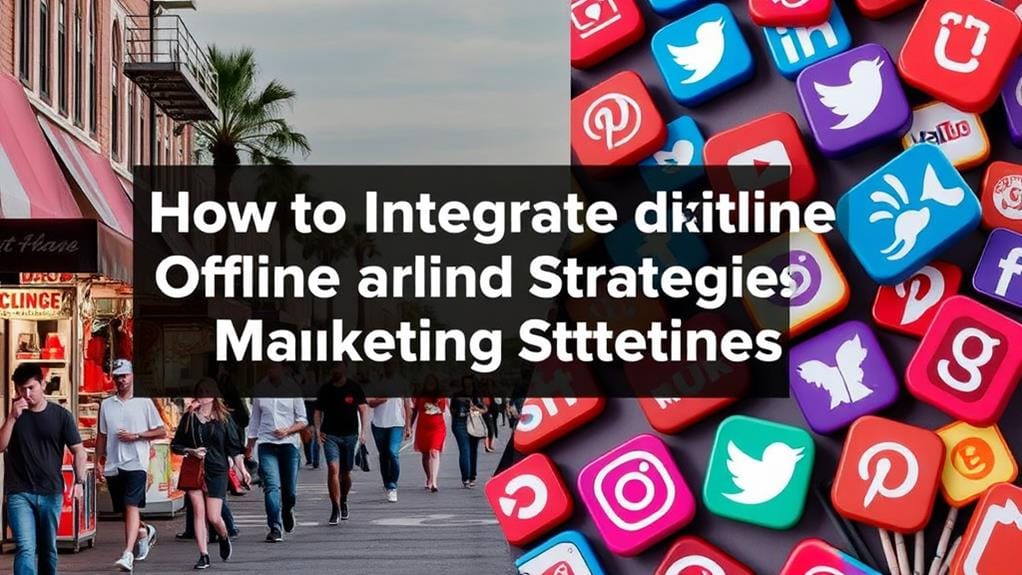How to Integrate Offline and Online Marketing Strategies
Integrating offline and online marketing strategies requires a strategic approach that bridges both domains for a unified brand message. Start by understanding your target audience through demographic, behavioral, and psychographic analysis. Set clear SMART goals aligned with your marketing efforts. Choose diverse channels that resonate with your audience and guarantee consistent messaging across them. Leverage social media alongside traditional print marketing to enhance engagement. Finally, track performance through established KPIs and adapt based on feedback and trends, creating a loop of continuous improvement. Explore further to reveal additional insights on refining your integrated marketing strategies.
Key Takeaways
- Align Branding Across Channels: Ensure consistent brand voice and visual identity in both online and offline marketing to strengthen recognition and trust.
- Utilize Data for Audience Understanding: Analyze demographic, behavioral, and psychographic data to create tailored messages that resonate across both marketing realms.
- Create Integrated Campaigns: Merge online and offline initiatives, utilizing digital platforms to promote events while offering live demonstrations to enhance engagement.
- Engage Through Multiple Formats: Incorporate interactive online content and offline experiences to foster community participation and deepen customer loyalty.
- Monitor and Adjust Strategies: Regularly assess performance metrics across channels, making necessary adjustments to enhance campaign effectiveness and ROI.
Understanding Your Target Audience

To effectively bridge offline and online marketing efforts, businesses must first dive deep into understanding their target audience. This understanding begins with thorough demographic analysis, which offers insights into who the potential customers are, including age, gender, and income levels. However, this is only the tip of the iceberg.
Organizations should also explore behavior patterns and the nuances of customer segmentation, enabling them to identify distinct groups within their broader market.
Further refinements come through psychographic profiling—examining values, interests, and lifestyles. This approach allows businesses to cultivate well-defined audience personas that encapsulate their target market's various motivations and preferred engagement styles. A better grasp of purchase motivations guarantees that marketing strategies resonate at a deeper level.
Equally important is recognizing engagement preferences, as they can drastically influence how audiences respond to both offline and online campaigns. For instance, while some segments may prefer interactive digital platforms, others might engage more positively with traditional media.
This calls for a flexible communication strategy that aligns with varying communication styles, guaranteeing messages are tailored for maximum impact.
Lastly, establishing reliable feedback loops is paramount. Regularly gathering and analyzing customer feedback not only enhances understanding but also fosters loyalty and trust.
The interplay of these factors creates a rich tapestry of audience insights, serving as the foundation for synchronized marketing efforts that effectively meet customer needs and aspirations.
Setting Clear Marketing Goals
Understanding the target audience lays the groundwork for effective marketing strategies; however, without clearly defined goals, efforts can become unfocused and dispersed. Setting clear marketing goals is fundamental for ensuring that both offline and online strategies align seamlessly. These goals serve as a compass, guiding marketing efforts towards meaningful outcomes and enabling brands to evaluate their performance against predefined benchmarks.
To achieve goal alignment, it is imperative to establish both short-term and long-term objectives. This dual approach facilitates a dynamic marketing environment where immediate actions address current market demands while also steering the overall direction of the brand. Goals must be specific, measurable, attainable, relevant, and time-bound (SMART), providing clarity and focus amid the complexities of an integrated marketing landscape.
Incorporating performance metrics is equally important. Analyzing these metrics allows marketers to assess the effectiveness of their campaigns, offering valuable insights into consumer engagement and behavior. Metrics such as conversion rates, website traffic, and social media interactions provide quantifiable evidence of success or areas requiring adjustment.
Moreover, the freedom of innovation within marketing strategies should not overshadow the necessity of accountability. A delicate balance between creative exploration and disciplined goal pursuit is what ultimately fosters sustainable growth.
Choosing the Right Channels

Selecting the appropriate channels for marketing is a strategic imperative that directly influences the effectiveness of both online and offline initiatives. Understanding the different platforms at your disposal is pivotal for developing outreach strategies that resonate with your target demographics while guaranteeing a harmonious media mix.
The careful consideration of channel effectiveness, audience segmentation, and promotion timing can notably enhance your campaign integration and achieve desired outcomes.
To navigate the multifaceted landscape of marketing channels, consider the following strategic steps:
- Identify Your Audience: Deeply analyze customer personas and their online/offline behavior. This enables you to better tailor your content and choose channels that align with their preferences.
- Assess Channel Diversity: Embrace a combination of different channels—including social media, email, print, and events—to reach your audience at various touchpoints along their customer journey. A diverse media mix optimizes engagement and maximizes reach.
- Align with Your Marketing Budget: Determine the financial resources available for each channel. Striking a balance between cost and channel effectiveness is essential for creating sustainable marketing campaigns.
Ultimately, achieving platform synergy through appropriate channel selection will empower your business to foster stronger connections with your audience and optimize the return on investment.
Developing a Unified Message
A unified message is essential for reinforcing brand identity across both offline and online platforms.
This involves strategically aligning the brand voice to resonate with target audiences while ensuring a consistent visual identity that reflects the brand's core values.
Aligning Brand Voice
Creating a cohesive brand voice is essential for any company aiming to harmonize its offline and online marketing strategies. A unified voice not only enhances brand authenticity but also establishes an emotional connection with the audience.
To achieve tone consistency, businesses should focus on three key areas:
- Brand Personality: Define the core traits that embody your brand. This clarity will guide your messaging across various channels, ensuring alignment with your values.
- Messaging Alignment: Consistency in your messaging reinforces the brand narrative. Every piece of content should resonate with your intended audience perception, regardless of the platform.
- Storytelling Techniques: Utilize storytelling to craft relatable narratives that engage and inspire. Strong stories can effectively convey your brand's essence, promoting cross-channel synergy while creating memorable experiences.
In this pursuit, understanding your audience's desires is paramount.
By developing strategies that emphasize these elements, you foster a unified brand voice that not only speaks but also listens.
Ultimately, achieving harmony in brand voice across all marketing efforts cultivates a profound connection with your audience, positioning your brand as both trustworthy and compelling.
Consistent Visual Identity
Establishing a consistent visual identity is essential for brands seeking to convey a unified message across both offline and online platforms. This consistency not only reinforces familiarity but also enhances brand recognition. To achieve this, brands must develop clear logo usage guidelines and adhere to specific brand color schemes that resonate with their audience's emotions and aspirations.
Typography consistency plays a pivotal role in visual identity; choosing typefaces that align with brand aesthetics fosters unity across various touchpoints. Additionally, ensuring image style uniformity through curated visual content strategy strengthens the narrative a brand wishes to portray.
Utilization of visual storytelling techniques will further elevate the brand's message, making it relatable and compelling. Design element cohesion is critical in crafting a visual presence that stands out. By employing graphic design templates and maintaining branding collateral uniformity, brands can streamline their promotional efforts, whether in digital or print media.
The essence lies in weaving together all facets of visual identity to create a harmonious representation of the brand. Ultimately, a well-executed visual identity can empower brands to express their unique essence while fostering deeper connections with their audiences.
Utilizing Social Media Effectively

To harness the full potential of social media, businesses must first implement strategic platform selection based on their target audience and brand objectives.
This tailored approach guarantees that the content created resonates effectively, leading to increased engagement and stronger community connections.
Platform Selection Strategies
Selecting the right social media platforms for your marketing strategy is crucial in reaching and engaging your target audience effectively. An effective platform selection requires a thorough understanding of your audience demographics and a keen analysis of the competitive landscape.
By leveraging various digital tools, you can guarantee content synergy across channels, enhancing your brand's overall impact.
To navigate the platform selection process, consider the following strategies:
- Conduct a Detailed Platform Analysis: Assess different platforms based on audience demographics, making certain they align with your target market's preferences.
- Monitor Market Trends: Stay informed on emerging trends that could shift audience behavior, allowing you to pivot quickly and efficiently.
- Allocate Your Budget Wisely: Understand the costs associated with each platform and allocate your budget for maximum impact, factoring in performance metrics and integration challenges.
Content Engagement Tactics
Effective content engagement is the cornerstone of successful social media strategies, as it transforms passive audiences into active participants in your brand narrative. To maximize this engagement, businesses should implement content personalization strategies that cater to individual preferences, thereby fostering deeper connections.
Incorporating interactive content formats such as polls, quizzes, and live Q&As elevates audience participation, inviting users to co-create experiences.
Employing compelling storytelling techniques can further resonate emotionally, making your brand's message relatable and memorable.
User-generated content not only diversifies visual content but also builds trust and authenticity, as consumers see real-life applications of your products.
Coupled with cross-channel promotions, this approach can seamlessly weave offline and online experiences, optimizing brand visibility.
Implementing community engagement initiatives fosters loyal customer relationships, creating a sense of belonging.
Additionally, experiential marketing tactics can elevate traditional engagement by allowing potential customers to experience your brand in innovative ways.
Incorporating Events and Experiences
Incorporating events and experiences into marketing strategies can greatly enhance brand engagement and foster customer loyalty. By merging the physical and digital environments, brands can create impactful interactions that resonate with their audience. This approach not only boosts visibility but also establishes emotional connections, effectively transforming potential customers into brand advocates.
To successfully implement experiential campaigns and event marketing, consider the following strategic initiatives:
- Live Demonstrations: Showcase your product in real-time to create interactive experiences that captivate your audience. This not only educates potential customers but engenders trust in your brand.
- Networking Opportunities: Host or sponsor events that encourage community involvement and foster connections among attendees. This creates a sense of belonging, enhancing the overall customer experience and encouraging word-of-mouth promotion.
- Brand Activations: Create immersive experiences that allow attendees to engage with your brand personally. These activations can leverage offline promotions such as contests or giveaways, generating excitement and immediate brand recall.
Events not only serve as a platform for audience engagement but also enhance your online presence when combined with digital promotion.
Photographs, videos, and live social media updates during the event can broaden your reach and increase engagement across channels. The synergistic combination of offline gatherings with online campaigns leads to a holistic marketing approach, creating a memorable impact that engages diverse audiences and builds lasting relationships.
Leveraging Print Marketing

While experiential marketing creates meaningful connections through events, print marketing remains a powerful tool to complement these efforts and engage audiences in a tangible way. The synergy between print and digital domains can amplify a brand's narrative, encouraging deeper connections with the target print audience. Effective print design plays a pivotal role in this integration, ensuring that promotional materials are visually appealing and consistent with the brand's identity.
Strategic print campaigns can enhance online efforts by providing a tactile experience that digital channels cannot replicate. Through targeted print distribution, brands can reach specific demographics, reinforcing messages delivered online. Print promotions can be leveraged to drive traffic to digital platforms, creating a cohesive marketing approach. For instance, including QR codes in print materials not only encourages interaction but also facilitates print tracking, allowing marketers to measure engagement and assess the print ROI.
To achieve true print integration with online strategies, businesses must cultivate print engagement through thoughtful design and messaging. When executed effectively, print campaigns yield a powerful return on investment, making a compelling case for incorporating print into the marketing mix.
This holistic approach, where offline and online strategies converge, promotes not only brand awareness but also loyalty among customers who appreciate the multifaceted nature of their interactions. By recognizing the unique advantages of print marketing, brands can access a freedom of expression that resonates and endures, ultimately driving growth and success in an increasingly competitive landscape.
Tracking and Measuring Success
To effectively measure the success of integrated marketing strategies, it is essential to establish clear Key Performance Indicators (KPIs) that align with both online and offline objectives.
This clarity allows organizations to utilize analytics tools effectively, converting data into actionable insights that drive strategic adjustments.
Setting Clear KPIs
Setting clear Key Performance Indicators (KPIs) is essential for any effective marketing strategy, as it serves as the compass guiding both offline and online initiatives. Establishing these benchmarks enables marketers to align their goals and make informed, data-driven decisions that facilitate both growth and freedom in their creative processes.
To effectively set KPIs, consider the following structured approach:
- Define Performance Metrics: Identify relevant performance indicators that effectively measure success in both domains, such as customer acquisition cost or return on investment.
- Establish KPI Benchmarks: Set realistic and achievable targets that reflect your objectives, ensuring they are rooted in historical data and industry standards.
- Implement Measurement Frameworks: Develop robust tracking methods that encompass various data sources, allowing for seamless integration of analytics across platforms.
This strategic assessment of KPIs and performance metrics empowers marketers to monitor progress, adjust campaigns accordingly, and ultimately optimize their strategies.
Utilizing Analytics Tools
With clear KPIs in place, the next logical step involves leveraging analytics tools to track and measure success across both offline and online marketing efforts.
Utilizing advanced analytics solutions is essential for discerning how various strategies synergize, giving businesses the freedom to pivot with agility.
One effective strategy includes implementing cross-channel tracking, which facilitates an integrated view of customer interactions.
By monitoring customer journeys through both digital and traditional touchpoints, brands can better understand user behavior and preferences.
This holistic data perspective empowers marketers to optimize campaigns in real-time.
Employing data visualization techniques also transforms raw data into actionable insights.
Visual representations clarify trends and patterns, making it easier for stakeholders to grasp complex information at a glance.
Tools like dashboards can showcase key performance metrics from both domains, offering clarity and focus.
Adapting to Feedback and Trends

How can businesses remain responsive in an ever-evolving marketplace? The key lies in establishing robust feedback loops, performing diligent trend analysis, and leveraging customer insights to craft adaptive strategies. By focusing on these elements, organizations can enhance their market responsiveness and ultimately drive growth through data-driven decisions.
To effectively adapt to feedback and trends, consider the following strategic approaches:
- Implement Continuous Improvement Cycles: Regularly assess marketing initiatives to measure their effectiveness. Utilize customer feedback to identify areas for enhancement and foster a culture of perpetual optimization.
- Engage with Your Audience: Create channels for two-way communication, such as social media platforms or customer surveys, to gather direct insights from your audience. This engagement fosters loyalty and provides invaluable context for your marketing decisions.
- Conduct Ongoing Trend Analysis: Stay ahead of industry shifts by monitoring market developments and emerging trends. By understanding these dynamics, you can pivot your strategies proactively, ensuring relevance and resonance with your target audience.
Harnessing feedback loops, embracing customer insights, and conducting thorough trend analysis are imperative for businesses seeking to thrive.
By adopting these adaptive strategies, companies can not only improve their market position but also enhance audience engagement and satisfaction.
In an environment where change is constant, the ability to respond to customer needs and market conditions will be the cornerstone of lasting success.
Creating a Consistent Brand Image
A consistent brand image is essential for businesses aiming to establish trust and recognition in a competitive marketplace. Developing a coherent narrative through brand storytelling allows a brand to resonate with its audience on a deeper level. When customers can relate to your brand's mission, values, and story, they are more likely to engage and advocate for you. This is particularly important in today's landscape, where consumers seek authenticity and connection.
Visual cohesion is a critical component of a unified brand image. Ensuring that your logo, color palette, typography, and imagery are consistent across both online and offline platforms reinforces your brand identity. This consistency creates a familiar visual language that communicates professionalism and reliability, enhancing customer confidence.
For instance, if you utilize a particular color scheme and logo in your print advertising, maintaining the same elements on your website and social media channels fosters a seamless experience for customers.
Furthermore, integrating offline and online strategies can amplify your brand's message. For example, a compelling offline campaign should direct consumers to your online platforms, where they can dive deeper into brand storytelling through engaging content.
Conversely, online campaigns can encourage interactions that translate into offline engagements, such as events or face-to-face consultations.
Frequently Asked Questions
How Can I Budget for Integrated Marketing Strategies Effectively?
Effectively budgeting for integrated marketing strategies necessitates a meticulous approach to cost allocation and resource optimization.
Begin by conducting a thorough analysis of both online and offline channels to identify potential return on investment.
Allocate resources based on performance metrics, ensuring flexibility to adapt as market dynamics change.
A strategic approach allows for the reallocation of funds towards high-impact initiatives, fostering a balanced marketing mix that maximizes reach while minimizing expenditure.
What Tools Help Manage Both Online and Offline Campaigns?
In the domain of marketing, where the digital winds meet the offline shores, effective campaign management requires strategic tools.
Platforms like HubSpot and Salesforce facilitate performance tracking and audience segmentation, while data analytics empowers cross-channel promotion.
These resources enhance customer engagement through content synchronization and lead generation, ensuring a harmonious blend of efforts.
How Do I Train My Team for Integrated Marketing?
To effectively train your team for integrated marketing, emphasize team collaboration and utilize diverse training resources.
Incorporate communication techniques that foster open dialogue among team members. Establish clear performance metrics to evaluate progress and success.
Implement feedback loops to guarantee continuous improvement and adjust strategies as needed.
Prioritize skill development tailored to the evolving landscape of integrated marketing, empowering your team to navigate both online and offline channels with confidence and creativity.
What Are Common Mistakes in Integrating Marketing Strategies?
Imagine a company launching a major campaign only to realize its online and offline messaging is starkly different, causing audience disconnect.
Common mistakes in integrating marketing strategies include misaligned goals and inconsistent messaging that ultimately confuse potential customers.
In addition, lack of collaboration can hinder effectiveness, with inadequate tracking and poor timing leading to ineffective channels.
Neglected follow-up actions can also result in lost opportunities, emphasizing the need for a cohesive, strategic approach.
How Can I Ensure Consistent Branding Across Different Platforms?
To guarantee consistent branding across different platforms, establish a cohesive brand voice and visual identity that resonates across all channels.
This requires an analytical approach to define your brand's core values and messaging.
Creatively integrate these elements into all marketing materials, guaranteeing synchronization in tone, aesthetics, and customer interactions.
Regularly review and refine your strategy, adapting to audience feedback while maintaining the freedom to innovate, ultimately fostering a recognizable and unified brand presence.
Conclusion
To summarize, the seamless synthesis of offline and online marketing strategies fosters a formidable framework for fostering brand awareness and customer engagement. By meticulously merging methods, maintaining message consistency, and maximizing media utilization, businesses can cultivate a compelling campaign that captures consumer consciousness. The dynamic interplay between diverse promotional platforms not only amplifies outreach but also strengthens stakeholder loyalty. Consequently, a strategic orientation toward integrated marketing promises profound potential for sustained success in an increasingly interconnected marketplace.




